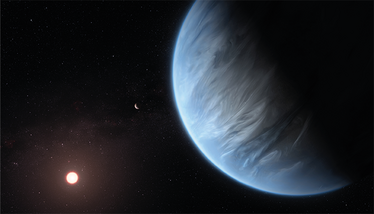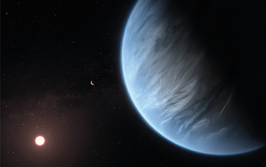Five Reasons to Be Skeptical About Life on K2-18b
And why a small degree of excitement might be justified nonetheless
| 3 min read

Credit: ESA/Hubble, M. Kornmesser, CC BY 2.0 via Flickr
Astronomers recently reported the strongest evidence yet of potential life beyond our solar system, detecting signs of dimethyl sulfide (DMS) and/or dimethyl disulfide (DMDS) in the atmosphere of exoplanet K2-18b using the James Webb Space Telescope (JWST). These compounds, produced primarily by marine microorganisms on Earth, have sparked global excitement about the possibility of life 124 light-years away.
Led by Nikku Madhusudhan at the University of Cambridge, the research team used spectroscopic analysis during planetary transits to identify the chemical signatures of DMS and DMDS. These findings strengthen K2-18b’s status as a candidate Hycean world – a planet with a hydrogen-rich atmosphere potentially covering a liquid ocean. The analysis combined earlier near-infrared observations from JWST’s NIRISS and NIRSpec instruments (0.8–5 microns) with new mid-infrared data from the MIRI instrument (6–12 microns), providing an independent line of evidence.
“Decades from now, we may look back at this moment as when the living universe came within reach,” Madhusudhan said. “This could be the tipping point, where the question of whether we’re alone in the universe becomes answerable.”
Feeling the hype? Here are five reasons to temper your enthusiasm.
Three-sigma significance isn’t definitive
The detection of DMS and DMDS has a three-sigma statistical significance, indicating a 0.3 percent chance the signals are random noise. In contrast, a five-sigma threshold (less than 0.00006 percent chance of a false positive) is the standard for a confirmed discovery. This gap, familiar to scientists validating trace signals, calls for more data. Researchers estimate 16–24 hours of additional JWST observations could achieve five-sigma confidence, but until then, skepticism is prudent.
Abiotic processes could mimic biosignatures
On Earth, DMS and DMDS are linked to marine phytoplankton, but K2-18b’s extreme environment – potentially high temperatures, pressures, or radiation – might enable non-biological chemistry to produce these molecules. Madhusudhan notes the detected concentrations (over 10 parts per million, compared to parts per billion on Earth) raise questions about abiotic sources, necessitating further study to rule out non-biological origins.
Spectral overlap clouds identification
The spectral signatures of DMS and DMDS overlap in the near- and mid-infrared ranges observed by JWST’s NIRISS, NIRSpec, and MIRI instruments. As the research team notes, “The spectral features of DMS and DMDS are sufficiently close in the observed bands that distinguishing them requires careful analysis and additional data.” This ambiguity makes it challenging to confirm which molecule (or both) is present, and higher-resolution spectroscopy or broader wavelength coverage is needed to clarify the signals.
Complex atmospheric chemistry adds uncertainty
K2-18b’s Hycean nature – a potentially water-rich world with a hydrogen-dominated atmosphere – introduces variables that could skew spectral interpretations. Factors like temperature gradients or stellar radiation may alter molecular stability or produce unexpected spectral features, as observed in studies of other extraterrestrial environments. Robust atmospheric models are essential to validate the findings.
Data may not show strong spectral features at all
A recent independent analysis of JWST’s mid-infrared MIRI/LRS data suggests that the evidence for any spectral features – including those attributed to DMS or DMDS – may be weaker than initially reported. Researcher Jake Taylor conducted a suite of statistical tests and found that, in five out of six cases, the data actually preferred a flat (featureless) spectrum over models including molecular absorption. Even when directly targeting the expected positions of DMS/DMDS features, the analysis yielded only a modest preference (around 2-sigma significance) for a Gaussian absorption feature – far below the threshold typically required for a confident detection. In other words, it’s possible that the MIRI data are simply consistent with a featureless atmosphere, which would significantly undermine claims of identifying biosignature molecules.
Nevertheless…
The fact remains: we now have (very tentative) evidence of molecules strongly associated with biological activity on a planet outside our solar system with water vapor signatures in its atmosphere and located within the “habitable zone.” This is the strongest hint yet of biological activity outside the solar system.

















